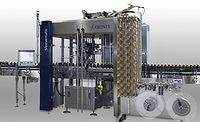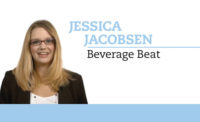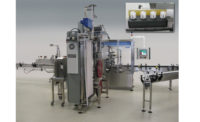Modular labelers support beverage labeling needs
Labeling equipment manufacturers design equipment to support SKU growth

Any cutting-edge invention, no matter how well-intentioned, has the potential to produce a chain reaction across other platforms. One area where this has come to fruition is the consumer packaged goods (CPG) market as suppliers, distributors and retailers accommodate SKU proliferation. As beverage-makers expand their portfolio whether it be flavors, packaging or both, labeling equipment manufacturers are developing machinery that can handle the effects of SKU proliferation.
“SKU proliferation has resulted in a need for greater flexibility in labeling equipment,” says Mike Soloway, product manager of labeling technology for Krones Inc., Franklin, Wis. “Varying bottle sizes and shapes, changing label materials as well as changing labeling technologies demand that the labeling equipment be future-proof.
“Modular labelers with swappable labeling heads are becoming more popular due to their ability to change not only bottle types, but labeling technologies as well,” he continues. “For example, we are seeing many customers migrating from cold glue labeling to pressure sensitive labeling, and modular systems allow these customers to swap back and forth between these technologies as needed.”
Bob Adamson, director of marketing, global filling and integrated services at Covington, Ky.-based ProMach, notes that growing SKU portfolios have placed increasing pressure on brand owners to make their products stand out.
“For beverage manufacturers, SKU proliferation means never-ending pressure to differentiate their products at the point of sale,” he says.
A byproduct of this pressure is the increased changeover. “More SKUs frequently mean shorter production runs, which lead directly to more frequent container and label changeovers,” he says. “More container and label changeovers drive equipment manufacturers to develop technology and machine features that make labeler changeovers as fast and as easy to execute as possible.”
Through Axon and P.E. Labellers, which are part of ProMach and P.E. Labellers North America, the packaging company is developing machinery that supports the demands of today’s beverage manufacturers.
“Axon shrink-sleeve label applicators feature tool-less container changeovers that can be easily completed in less than 10 minutes,” Adamson says. “P.E. Labellers pressure sensitive label applicators also offer fast, tool-less changeovers and their dual labeling station configurations enable operators to load the next label on a redundant labeling station, and when the current run ends, the redundant labeling station is ready to run in less than sixty seconds. This makes flavor and SKU changes fast and simple to execute.”
Justin Slarks, director of marketing for Sleeve Seal, highlights how the Little Rock, Ark.-based company has seen the increase of SKUs impact its business.
“Sleeve Seal is seeing an increase in sales and some of this is clearly the result of SKU proliferation,” he says. “Manufacturers are looking for reliable equipment that can be changed over easily and deliver high efficiencies. The ability to label a range of products at speed is increasingly critical.”
Versatility in mind
As experts have noted, the growth of SKUs has placed a greater need for labeling equipment that is flexible in today’s packaging environment.
“Sleeve Seal is engineering machines with controls that take the manual input of the operator out of the equation,” Slarks says. “This reduces changeover times and provides higher efficiencies with repeatable performance.”
Krones’ Soloway echoes similar thoughts when it comes to quick, efficient changeovers. “The process of changing over from one product to the next must be as quick and as straightforward as possible,” he explains. “Krones accomplishes this by using tool-less, dedicated change parts and by automating more and more of the labeler adjustments to avoid inconsistencies that can result from having multiple operators setting up the machines.”
Soloway adds that for large scale packaging operations, flexibility isn’t an isolated incident but one that impacts all packaging lines.
“Large scale beverage operations are finding it more and more difficult to dedicate a line to a specific product that runs 24-7,” he says. “The proliferation of SKUs has resulted in the need for all lines to be flexible. This in turn has resulted in the integration of flexible, modular labeling machinery throughout their operations.”
In addition to higher speeds and quick changeovers, ProMach’s Adamson says that labeling equipment manufacturers are integrating labeler and tamper band applications into a single bloc as well as coupling redundant production capabilities to further reduce downtime.
“P.E. Labellers offers integrated bloc configurations that apply labels and then tamper evident bands to containers,” he says. “This saves valuable floor space, enhances container flow, and helps provide tamper band security for consumers.”
‘Primary’ care
Although SKU proliferation plays a vital role in packaging machinery needs, evolutions within the primary packaging market also have impacted products like labeling equipment.
“We are seeing a steady migration from glass bottles to aluminum cans in the beer and wine markets,” Krones’ Soloway says. “Small- and mid-size companies are finding it difficult to purchase and stock pre-printed cans in every flavor, so they are opting to purchase brite cans in bulk and then label them on demand using either pressure sensitive labels or shrink sleeves.”
Sleeve Seal’s Slarks also details how beer and other adult beverage manufacturers are utilizing pre-printed aluminum cans.
“Craft breweries and adult beverage-makers are moving toward the use of labels on cans since the way the can manufacturers have changed the way cans are sold,” he says. “A brewery can warehouse cans with no decoration, lace up new film and switch over to another SKU quickly and easily.”
Yet, beverage alcohol is not the only sector of the beverage market that is turning to aluminum cans. ProMach’s Adamson highlights how vanguard beverage categories are selecting this primary packaging format and thereby seeking out labeling equipment that supports their branding.
“New shapes and sizes of aluminum cans are growing in popularity,” he says. “Popular applications include coffee drinks, energy drinks, wines, and of course, craft beers. This trend is impacting labeling because shrink sleeve can decoration is much more colorful and compelling than printed cans. Buying and shrink labeling bright cans, instead of buying and storing truckloads of printed cans, is a great cost saving alternative.”
However, aluminum cans are not the only packaging format that popular beverage categories are using. Adamson notes that premium waters, functional waters, coffee drinks and kombuchas are using PET and glass bottles. Many of these brands are turning to pressure-sensitive labels, he adds.
“Clear pressure sensitive labels with high-impact graphics, front and back pressure sensitive labels and full-wrap pressure sensitive labels are all growing in popularity for these premium products,” he says. “P.E. Labellers Modular Top and Modular Plus pressure sensitive labelers are ideal solutions for beverage manufacturers because they are available in low, medium and high-speed models and they can be configured to apply multiple labels to individual containers.
As beverage-makers adapt to the demands of today’s consumers, labeling equipment manufacturers are in a position to support those changes from a packaging perspective. BI
Looking for a reprint of this article?
From high-res PDFs to custom plaques, order your copy today!






